NASA Develops Wireless Sensors to Detect Lightning Strike Damage to Composite Aircraft Computational electromagnetic software enables a small team of researchers at NASA's Langley Research Center to develop wireless resonant sensors that can measure and mitigate lightning strike damage to composite aircraft.

Statistics on aircraft lightning strikes indicate that in a typical year of operation, a transport aircraft is likely to receive one or two lightning strikes. Depending on geographical regions, flight altitudes, routes and traffic patterns, the frequency of lightning strikes occurring can be higher than average.
Lightning strikes are a safety hazard to aircraft, especially those manufactured with a considerable amount of composite materials compared to traditional aluminum-skinned designs. When a lightning strike occurs on an aircraft, the points of attachment and detachment on its surface must be found by visual inspection. Then, maintenance staff must assess any damage to ensure safe flight operations. At the NASA Langley Research Center, Hampton, VA, researchers are focused on how a NASA-developed wireless sensor technology can be applied to lightning strike protection, damage detection and damage diagnosis on composite materials used in today's aircraft. FEKO™ – a comprehensive electromagnetic simulation technology in Altair's HyperWorks® suite – in combination with optimizing and validating sensor designs helps fast-track readiness for aircraft safety and commercial applications.
A Unique Sensor
The Sans Electrical Connection (SansEC) sensor is a wireless electromagnetic resonator that can sense changes in electromagnetic impedance of the materials in its close proximity. According to George Szatkowski and Kenneth Dudley, senior researchers at the Langley Research Center, it can measure electrical, mechanical, thermal and chemical phenomena. What's more, it can detect and identify delamination, punctures, voids and rips in composite materials.
Dudley explains that the sensor is a conductive spiral that can be any shape, such as square, triangular, etc. The conductive spiral is an "open" circuit and is not directly wired to any source power.
The sensor is powered using time-varying electromagnetic fields to generate a resonant condition on the sensor. When activated by oscillating magnetic fields from a low power transponder, the sensor transmits an electromagnetic response, whose frequency, amplitude and/or bandwidth can be correlated to the magnitude of one or more physical quantities. A remote antenna "interrogates" the sensor and collects the electromagnetic response.
Dudley explains that unlike other sensors, a SansEC sensor can be designed for measurements unrelated to each other, like temperature and fluid level, and switch easily from one to another or do both simultaneously.
What makes the SansEC sensor unique is that its open-circuit design has no conventional electrical connections, making it highly resilient to damage. Traditional closed-circuit sensors use electrical connections that can be degraded or damaged and have the potential for electrical arcing.
In addition, the SansEC sensor operates as a single component. It weighs less than its closed-circuit counterparts and can be manufactured at a lower cost. It uses fewer materials, requires less time and labor, produces less waste, and has a broad range of applications.
In the Lightning Lab
Szatkowski and Dudley are part of the Lightning and Electromagnetics Effects Mitigation (LEEM) element supported by the Atmospheric Environment Safety Technologies (AEST) project. AEST's areas of research include engine icing, airframe icing, and atmospheric hazard sensing and mitigation. The NASA AEST research focuses on enabling pilots and controllers in the National Aerospace System to obtain real-time, accurate information on a range of atmospheric hazards, leading to improvements in operational efficiencies.
When lightning strikes an aircraft made out of aluminum, the metal conducts the current and voltage across the aircraft, typically off the tail or wing tips. Composite skinned aircraft do not possess the same level of conductivity and require additional design requirements to provide lightning protection.
NASA researchers conduct physical experiments of lightning strikes, analyze the data and feed it into the FEKO solver – a comprehensive electromagnetic simulation technology that is now part of the Altair HyperWorks suite – in order to improve designs of the SansEC sensor
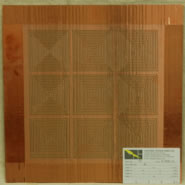
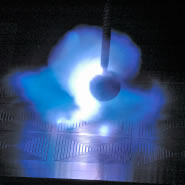
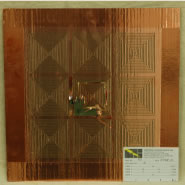
Szatkowski explains that to address this issue, aircraft manufacturers apply a thin metal shell on the exterior of composite aircraft to act like a "Faraday cage" – a metal mesh that essentially increases the conductivity of the surface to reduce the voltage across the aircraft. The shell adds conductivity to help reduce the lightning skin damage and prevent avionic upsets and currents entering the fuel tank; however, it also adds weight. In addition, aircraft paint typically coats the thin metal shell. An anomaly in the paint could be enough to create an electric field enhancement at that region, resulting in lightning attachment at the anomaly.
The SansEC sensor, which is made of a thin, lightweight planar conductor, could eventually replace this metal shell. Szatkowski and Dudley note that the sensor can detect damage beneath the surface of the composite not visible to the human eye, providing a "structural health-monitoring" capability.
How do the sensors work in a lightning environment? "When lightning is propagating through the atmosphere," says Szatkowski, "it has a very strong electromagnetic field preceding it. Our sensors are designed to resonate in band with the lightning spectrum, which will energize the sensor and establish the modal structure – essentially turning the sensors on when there is lightning present. The highest electrical field region on the sensors is where the lightning will want to attach.
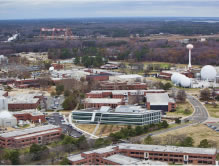
Langley Research Center
The Langley Research Center is one of 10 NASA research facilities. Located in Hampton, VA, its workforce includes about 1,900 civil servants and 1,800 contractors who work on aerospace systems that can perform in our own atmosphere, on the Moon or Mars, or anywhere that NASA explores with aircraft, spacecraft and satellites.
Major areas of accomplishment include:
- Developing technologies to make airplanes safer, quieter, faster and more fuel efficient and environmentally friendly
- Managing development of the Orion crew module launch abort system
- Testing a new concept for a heat shield, known as a Hypersonic Inflatable Aerodynamic Deceleration, or HIAD
- Tracking and studying pollution, smoke and fires from aircraft and spacecraft to better understand the impact of aerosols in long-term climate change
"Where this would be of particular interest," continues Szatkowski, "is the fuselage." He explains that approximately 50% of lightning attachments occur on the fuselage. The lightning hits a nose or a wing tip, and as it sweeps through – as the airplane is moving through that arc attachment – it typically attaches on the fuselage.
"With our sensors," he remarks, "we can artificially enhance the electrification at a given point on the sensor, based on its design, and that will draw the lightning into that point. It's my philosophy that if you can design where the lightning is going to go, you can also design that location to be more robust."
Dudley notes, "If we can create a preferred impedance path to direct the lightning to a hard point on the aircraft or an edge extremity, it can then safely exit the aircraft and continue onto ground."
Currently, the team is testing a sensor that measures 16-in. square. The benefit to the larger size is it will generate multiple resonate harmonics in band with the radiated lightning spectrum. Previous research focused on 8-in. and 9-in. square sensors.
Another area of investigation is combining individual sensors into arrays. SansEC arrays can be tiled across the surface of an aircraft, either along the fuselage or across the wings, similar to bathroom tiles. Clever variations of the tiling placement could create a more opportune impedance path to the plane's edge or ground points, thanks to the electromagnetic coupling between the sensors. This coupling effect enables the sensors to act more powerfully in concert.
Researchers are also focused on the sensor's ability to detect damage from lightning strikes as well as damage within composite structures (ranging from material fatigue to foreign objects hitting the aircraft, such as hail or birds). The sensors can alert pilots to damage as well as provide situational awareness of a vehicle's health in unmanned aircraft.
Dudley says, "The changes in the frequency shift of the SansEC sensor – the way it shifts, the amount it shifts, the amplitude changes in the frequency – enable us to diagnose the nature of the damage. We are still working on this but have demonstrated the capability and feasibility in laboratory demonstrations."
Cooking with Fire
Research on the SansEC sensor began several years ago. According to Dudley, the sensor always performed well in physical experiments the team conducted.
During the first year of research, the team decided to implement computational modeling techniques. Since NASA researchers knew of FEKO and its electromagnetic simulation capabilities, they secured a license. One team member was designated to create computational models of the sensor as well as material models of composite layers. After coming up to speed on its capabilities, the software enabled the team to validate their physical experiments.
In the second year, the team applied the software to specific areas of study. Dudley explains, "We built a series of models to inform our experiments. First, we validated the things we already knew. Once we saw that the physical and computational results matched up, we knew we were cooking with fire and could use FEKO to inform us on the direction to take with our physical experiments."
As the team's confidence in the software's capabilities grew, so too did the application of the tool. For example, research on composite materials advanced from "simple" – defining the composite model as a solid sheet with a particular electrical property, dielectric properties and conductivity – to more "complex" – modeling individual fibers put together in a sheet, then stacking the sheets and rotating them to evaluate the layups of different composite matrices.
The team also used FEKO's time domain capabilities to investigate lightning strike attachments toward sensors. Dudley says, "With this software, we gained deep insights that we could not have acquired through physical experimentation alone." He explains that the team would look at the surface currents and electric field distributions on a sheet or sensor and review how they were emerging. From that, the team would tie electromagnetic first principles to what they were observing in the computational models back to the physical experiments.
"This led us to make incredible leaps in understanding how our sensor worked and interacted in a lightning environment or in a damage-detection application," says Dudley.
"Once we would get a series of computational models," he continues, "we would conduct an experiment in the lightning lab or in our high intensity radiated fields' chamber. For example, we would set up a shield-effectiveness experiment in which we would propagate a wave from one side of the sensor through a wall to the other side and characterize the amount of energy rejected due to the sensor, then compare it with the computational models.
"We would then build material models, go to the shop, and lay up a particular weave or orientation of a composite material matrix. We would lay out a sensor array, strike it and observe the physical experiments. From that, we would analyze the data from the physical test, take that new knowledge, feed it back into FEKO and lead to improved designs.
"In this method of using the computational electromagnetic modeling tool to inform our experiments, then feed experiments back into this computational model in an iterative approach, we achieved a science force multiplier for a small team of five. We were able to produce results more quickly and accurately than one would expect from a team of our size."
To increase the efficiency and productivity of simulations, the team has upgraded to a 4-CPU license from a 1-CPU license. Previously, depending on the complexity of the model, analysis on a problem could take 24 hours. Now, with a parallelized 4-CPU version of the software running on a faster PC cluster with multi-core capability, getting results can take as little as 30 minutes.
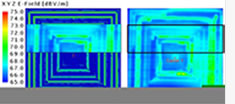 Left: Image of an electric field map of a SansEC sensor. Right: Image of IR thermal data during lightning strike displaying the attachment (where lightning resided on the sensor). This is a rough estimate showing correlation between the high electric field on the sensor to the lightning attachment location.
Left: Image of an electric field map of a SansEC sensor. Right: Image of IR thermal data during lightning strike displaying the attachment (where lightning resided on the sensor). This is a rough estimate showing correlation between the high electric field on the sensor to the lightning attachment location.
The FEKO Solver
With the acquisition of EM Software & Systems – S.A. (Pty) Ltd. in June 2014, Altair added the FEKO® solver to its HyperWorks® suite.
Typical applications of FEKO include antenna design and placement, electromagnetic com- patibility analysis, bio-electromagnetics, radio frequency components, 3D electromagnetic circuits, design and analysis of radomes, and radar cross-section analysis.
The name FEKO is an abbreviation from a German phrase, "field computations involving bodies of arbitrary shape." The addition of FEKO to the HyperWorks suite will help to address coupled electromagnetic-thermal and electromagnetic-mechanical problems, among others.
According to Dudley, the quick processing enables the team to explore even more complex models. It also opens the door to investigate the use of SansEC sensors on full-scale aircraft models. Szatkowski envisions a "smart skin" concept using surface tiling arrays of SansEC sensors. The concept could be carried out in a couple of ways. The first approach is one in which the sensors would be interrogated for lightning strikes through antennas embedded on the composite, or by direct wiring to the sensors themselves. Instrumentation on board would quantify the health state of the aircraft.
The second approach would allow the interrogation system to be external to the aircraft. Ground inspection crews or maintenance personnel would conduct the structural health measurement post flight, enabling the SansEC sensors to assist in the visual inspections.
Modeling a full-scale composite aircraft is an extremely challenging problem. According to Dudley, such a model would incorporate realistic composite properties, including the electrical properties of the composites, which are vastly different from the highly conductive aluminum-skinned aircraft. Adding the modeling of the SansEC sensors increases the computational complexity of the problem. Having a comprehensive simulation tool like FEKO combined with powerful computer clusters, the research team hopes to one day overcome the challenge.
Technology Transfer
While much of the SansEC sensor research has been focused on lightning strike protection, damage detection and damage diagnosis of composite aircraft materials, the sensor technology has much broader applications.
Szatkowski explains that the SansEC resonance sensor can be used in various industrial and medical applications. For example, the automotive industry could use the sensors in tire applications to monitor for punctures, temperature, rotation rate or wear. In the food industry, sensors could detect spoiled products. In the oil and gas industry, they could be used to test for water levels, iron or salinity, blockages, leaks or pipe integrity. In addition, the medical and biomedical segments could add SansEC sensors in bandages to monitor wounds. NASA is currently collaborating with industry on technology transfer.
According to the researchers, the uses for the SansEC sensors – and computational modeling – are nearly limitless.
For more information on FEKO, www.c2rmagazine.com/2015